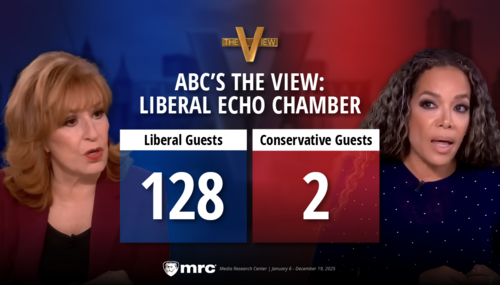On Tuesday morning, the Media Research Center unveiled its latest arm, MRC Latino, with a symposium in Washington, DC on imbalance and unfairness in Hispanic media, beginning with Univision and Telemundo, introduced with remarks by Sen. Rand Paul. It's time for conservatives to participate more fully in Hispanic media, and for those outlets to present both sides of the nation's most important debates.
MRC Latino director Ken Oliver-Méndez released the findings of a new report called “Hispanic Media in the Balance” (written with MRC research director Rich Noyes) that assesses how much national Spanish-language newscasts on American TV tilt to the left. Take a peek at the summary:
With a combined audience of approximately three million, the national evening newscasts of Univision and Telemundo have a viewership that rivals that of the top 10 cable news shows. Yet up until now, news coverage on these major U.S. Spanish- language networks has not been subject to consistent conservative engagement and scrutiny for fairness, accuracy and journalistic integrity.
For four months, from November 1, 2013 through February 28, 2014, the Media Research Center undertook just such scrutiny, analyzing nearly 1,000 U.S. and international issue- oriented news stories aired on the flagship weekday evening newscasts of Univision and Telemundo (Noticiero Univision and Noticiero Telemundo).
This study found a marked leftward tilt in both networks’ news coverage, particularly in reporting U.S. domestic policy news, with Democratic, left-leaning sources overwhelmingly dominating U.S. coverage. In international news, however, both networks maintained a more critical and/or balanced stance in relation to governments in the region, as is the journalistic norm.
MRC’s analysis examined, where applicable, three constitutive elements in the networks’ coverage of each domestic policy topic: the conservative or liberal orientation of politicians and advocates cited; the conservative or liberal orientation of organizations cited; and the predominating tilt or “spin” (liberal or conservative) of the story.
The prevailing tilt of a story was determined by tallying all statements from journalists and quoted sources that articulated either a recognizably liberal or conservative point of view on a given subject. If the total of these comments were tilted in either direction by a greater than three-to-two margin, then the story was scored as having either a “liberal” or “conservative” spin. Otherwise, the story was classified as “neutral” or “balanced.”
Among the major findings of the MRC’s first-ever study of the news on the nation’s top Spanish-language television networks:
Domestic Overview
-- In coverage of U.S. domestic policy (667 stories), Democratic politicians and spokespeople for left-leaning/liberal advocacy organizations such as the ACLU, National Council of La Raza and various labor organizations were quoted nearly three times as often as Republican politicians and spokespeople for conservative counterpart organizations such as the Latino Partnership for Conservative Principles, the Heritage Foundation and the LIBRE Initiative (1,011 to 370 appearances and/or direct quotations) on Univision and Telemundo newscasts.
-- The top three U.S. domestic policy topics covered by both newscasts were immigration law enforcement, immigration reform legislation in Congress and ObamaCare. The majority (170, or 59%) of Univision and Telemundo’s 288 stories on these three issues tilted left/liberal. Only 21 stories (7%) tilted towards the right/conservative, while the 97 remaining stories were neutral or balanced.
-- None of the Obama administration’s various scandals (the IRS targeting of conservative groups; Benghazi; etc.) were even once mentioned during this four month study.
ObamaCare
-- Despite ObamaCare’s problem-plagued rollout and controversial implementation, Univision and Telemundo reporting featured advocates of ObamaCare over its conservative opponents by a margin of nearly five-to-one (116-24).
Immigration
-- On the subject of immigration reform, Democrats and spokespeople aligned with left-leaning pro-reform organizations made well more than twice as many appearances as conservatives and Republicans (287-135).
-- In news related to immigration law enforcement, the ratios were also lopsided, with Democrats and advocates for more liberal immigration law enforcement policy appearing four times as often as conservatives and law enforcement officers combined (184 to 45).
Venezuela
-- On the other hand, Univision and Telemundo’s coverage of Venezuela’s socialist government was decidedly critical, with 39 of the stories about the situation in Venezuela favoring anti-government protestors, while just one tilted in favor of the government. Soundbites heavily favored the opposition by a two-to-one margin (154 vs. 73).
Catholic Church
-- The majority of both networks’ coverage of the Catholic Church was favorable, as 49 of the 95 stories (52%) favored the Church, compared with 30 (31%) neutral/balanced and 16 (17%) that tilted against the Church. Talking heads in these stories were mostly prelates or other pro-Catholic sources, who outnumbered critics by a greater than three-to-one margin (145 to 40).
Conclusion
This study of the news programming on America’s leading Spanish-language television networks coincides with the launch of MRC Latino, an operational arm of the Media Research Center that will conduct ongoing analysis of these networks, with the objectives of improving conservative participation in this segment of the media’s news programming, as well as holding these outlets accountable to the same standards expected of other major networks, for comprehensive, fair and accurate news coverage.
Our first examination shows America’s top Spanish-language news networks are failing to fully live up to their journalistic vocation when they let their domestic news content be dominated by partisans on one side of the ideological spectrum. This situation will only improve to the extent conservatives are more successful in making their voices heard, and the networks do a better job of including conservative voices and views in their coverage of the news. Just like the rest of America’s news consumers, viewers of U.S. Spanish-language networks deserve news coverage that is comprehensive, fair and accurate, adhering to the highest standards of journalistic integrity.




